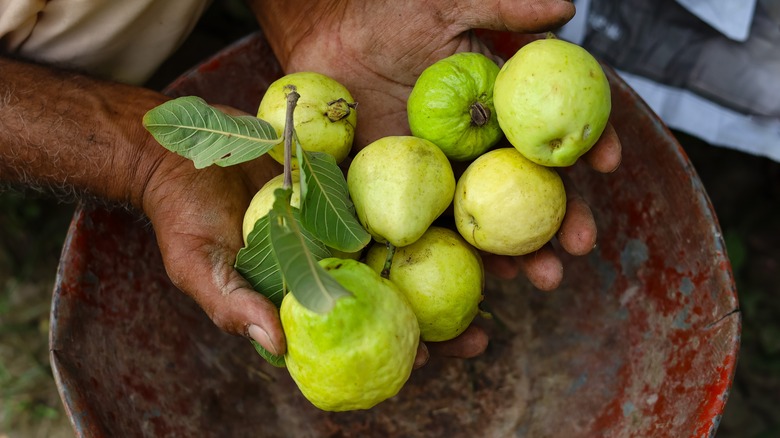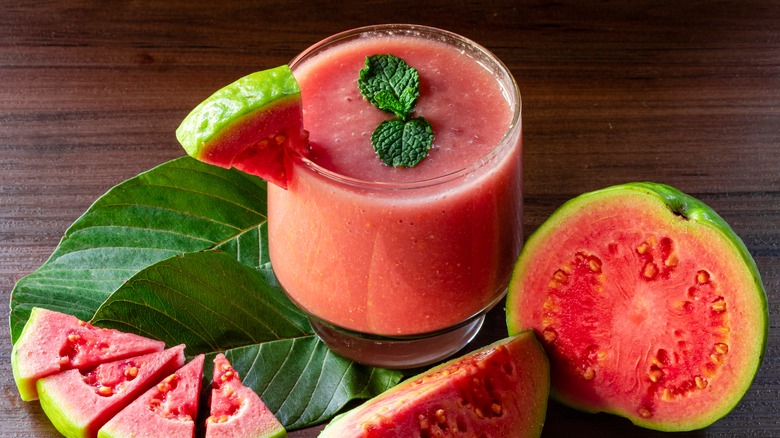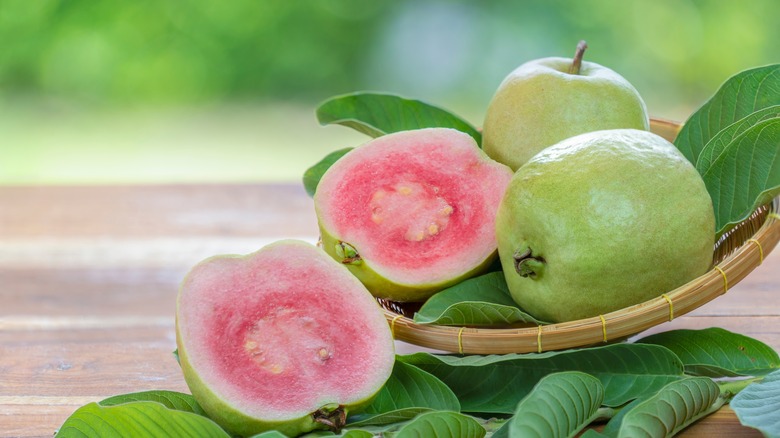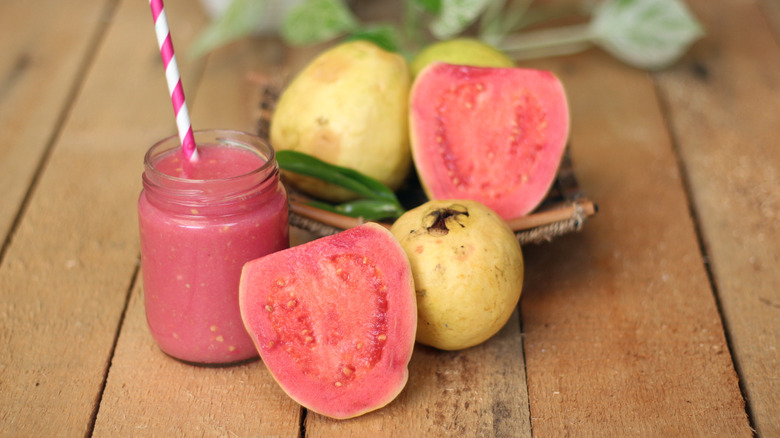Most Of The World's Guava Comes From This Country
The world loves fruit! You are probably thinking, "Well, duh! Who doesn't like fruit?" After all, it is nature's candy. Small and sweet things like figs, peaches, strawberries, and marionberries are wonderful to eat fresh off the vine. You're probably a fruit lover because they are perfect to use to decorate baked goods, chop into fruitcakes, blend into smoothies, and bake into pies and tarts. Fruit has been used for centuries to naturally sweeten up people's lives, and one of our favorites is the guava.
You might have had some guava juice or soda, or maybe even guava pastries, but odds are unless you grew up in one of the hot and humid places the guava is grown, you haven't eaten one fresh off the tree. The guava is almost pear-like in shape and usually has green or yellow skin protecting a pink or white flesh which is incredibly sweet (via Lacademie). So, which country has a monopoly on these fruity treats?
India and the guava
Guavas thrive in warm climates, and in Southern Asia under Nepal and extending into the ocean lies a country made up almost entirely of tropical and subtropical zones — that country is India. India's climate makes it ideal for growing tropic-loving crops such as black pepper, cardamom, and rice. Though guava fruit is not native to the country, India is currently the largest producer of sweet stuff. According to the Food and Agriculture Organization, India is the largest producer of mangos, guavas, and mangosteens, and when combined, their total tonnage adds up to 24,748,000, whereas the second largest producer, Indonesia, only grows 3,617,271 tons.
Guavas can grow year-round in warm climates, and the trees can produce a crop twice within a 12-month time span and are picked immediately upon reaching maturity by hand or by machine (via Rehoboh Organic Farms). World Atlas says that though the guava tree can grow anywhere in India, the regions which are best at producing the world's guavas are Uttar Pradesh, Punjab, and Haryana. China and the United States are the two largest countries to import guava followed next by the Netherlands, Germany, and the United Kingdom (via Tridge).
The history of the guava
Though it certainly thrives in South Asia, the guava is not native to India, nor the East itself. My Recipes says that guava is truly native to Mexico, Central America, the Caribbean, and South America. The guava tree will produce a fruit with yellow and green skin and a gorgeous pink color on the inside which is notable for its strawberry and tropical fruit flavor. It was introduced to the United States in the 19th century and now grows in Florida and Hawaii. Europeans first touched base with the guava in Haiti, and the Portuguese and Spanish colonists then proceeded to spread it around the world. In the 17th century, the fruit was introduced to Indian soil (via American Indian Health and Diet Project).
Guavas are delicious fruits, which is why their juice has been used to flavor drinks like Hawaiian Sun, Monin, spicy rum sauce, and even turned into candy! It is a massively popular fruit in the more tropical parts of the globe including Hawaii, but unfortunately, the Pacific Islands have run into a bit of trouble regarding the guava plant. According to JSTOR Daily, the Brazilian strawberry guava is extremely invasive in the state and is heavily disrupting native plant life on the islands.
Culinary and nutritional values
You might think of the guava as a single variety of fruit, but much like apples, grapes, and peaches, the guava comes in quite a few colors and flavors. Gardening Know How says that some of the most popular guava varieties happen to be the Red Malaysian (notable for its attractive red color), Tropical White (which has yellow skin), Mexican Cream (super sweet and dessert-like), Strawberry guava (bet you can guess what that tastes like), and the Lemon guava (that has yellow flesh).
Britannica says that the guava (Psidium guajava) is a fantastic fruit to turn into jam and jelly, to pipe into a pastry, and to use in any dessert really! But besides their wonderfully sweet characteristics, guavas are incredibly rich in vitamins, and their skin can even be consumed to add some additional fiber to your diet. According to Healthline, there is also evidence that eating fresh guavas regularly can improve your blood sugar, heart health, and even menstruation cramps. At the end of the day, eating any fresh fruit will be good for your body, but the guava, with its unique and unmistakable sweet aroma and taste, is hard to beat! So, next time you see guava on the dessert menu or see it freshly chopped up to eat, feel free to grab a slice. If you're a fruit lover, you won't be disappointed!



